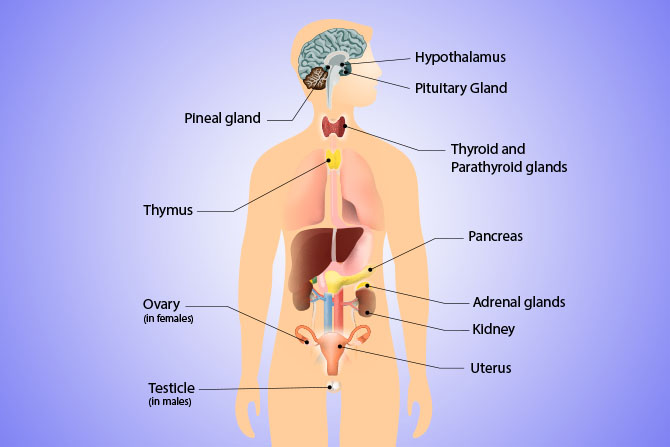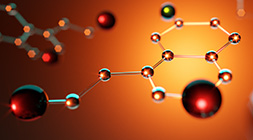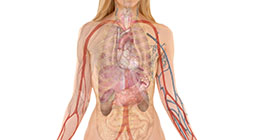
The endocrine system is made up of glands that produce hormones. Hormones are chemical messengers that tell other systems throughout your body what to do, how to do it, and when to do it. The messages they send could be to make you sleepy like melatonin does; or to rev up your energy supply to meet the next deadline, which is what occurs when cortisol is secreted; or raise your blood pressure, which aldosterone can do; or to release an egg, like luteinizing hormone signals, or get you in the mood for love (thanks to an increase in testosterone).
Many hormones are secreted in the body—over 50 are known at the moment. There are thousands of body processes that occur because of your hormones. This “complicated” interaction means that if you tinker with one component of a hormone process, you may interfere with every process related to it. There can be a domino effect (or a “cascade effect”) that can affect every hormone down the chain.
Remember this: hormones work together. When the correct amount of the right hormone is in the right place at the right time, you have beautiful, clear skin; strong bones; and a great sex drive. You have strength and stamina, are breast-cancer-free, and prior to menopause, you are fertile (as Nature intended you to be).
Hormone Messengers Control the Body
You were not born with a lifetime supply of hormones. Organs, glands, and cells in your body, mostly those in your endocrine system, secrete hormones into your bloodstream. Once it has traveled through the bloodstream, the hormone acts like a key that fits into a lock on specific target cell membranes. The lock is called the receptor. Sometimes the hormone (the key) fits the lock exactly, and other times it alters the action of the lock. Some of these “locks” can take more than one key (meaning several hormones can affect it).
The endocrine system makes these powerful messengers day in and day out from building blocks like cholesterol, amino acids found in protein, or components of fats in your diet. The three types of hormones are summarized in the table below.
| Hormone Type | Source(s) | Selected Examples |
|---|---|---|
| Steroid hormones |
|
progesterone, testosterone, estrogens (including estradiol, estrone, estriol), cortisol, prostaglandins, DHEA (dehydroepiandrosterone) |
| Peptide (protein) hormones |
|
insulin, luteinizing hormone, follicle-stimulating hormone, prolactin, growth hormone, dopamine, antidiuretic hormone |
| Amine-derived hormones |
|
melatonin, serotonin, epinephrine, thyroxine |
In the presence of stressors, the immune system and endocrine system work as an integrated circuit. Deficiencies in the immune system and abnormalities in the cross talk with the endocrine system can make a person more susceptible to developing chronic inflammatory disease, autoimmune disease like lupus, rheumatoid arthritis, a reduced ability to fight infections, osteoporosis, muscle atrophy, rapid aging, poor antibody production against vaccines, and more. Modulating or keeping cortisol levels in balance through a healthy diet, nutritional supplements, and stress reduction are key to disease prevention.
Hypothalamus
The hypothalamus sits just below what is called the base of the forebrain, so it is in the lower part of the front of the brain. It manages the regulation of the body’s internal environment by taking signals from the nervous system and sending out hormone messages to the pituitary gland, directing it to either start or stop a hormone process.
The Pituitary Gland
The pituitary gland is only about the size of a pea, but it has a front and a back— the anterior lobe and the posterior lobe—that each produce specific hormones in response to a signal from the hypothalamus. The instructions for action that go out to the kidneys, uterus, mammary glands, thyroid, adrenal cortex, ovaries, and bones and tissues come from the pituitary gland.
Adrenal Glands
The two adrenal glands are among the most important glands in the body. These small glands release the stress-response hormones that guide the body’s reaction to a stressor, as well as small amounts of estrogen, testosterone, DHEA, cortisol and progesterone. The accumulated effects of internal and external stressors have a profound impact on the adrenal glands, an impact that ripples out into the area of hormone health.
Each adrenal gland sits on top of one of the kidneys and contains two parts: the adrenal medulla and the adrenal cortex. In response to triggers from the hypothalamus, the adrenal medulla secretes hormones called epinephrine (aka adrenaline) and norepinephrine. These hormones are part of the “fight-or-flight” response that cause that fast, short-term increase in blood sugar levels; breathing rate; cardiac output; blood flow to the muscles, lungs, and brain; and cellular metabolism that can get you moving when you think you are in danger.
The adrenal cortex is responsible for the production of a wide range of hormones called glucocorticoids, including cortisol, and the mineral corticoids aldosterone and testosterone. This release happens in response to a signal from the pituitary gland and results in a longer-term stress response that increases blood glucose as well as suppresses your immune response, in order to concentrate your energy on dealing with the stressor.
The secretion of hormones by the adrenal cortex in response to stress is one of the most important functions of the adrenals as these hormones help you adapt to the stresses of life over the longer term. Various adrenal hormones stimulate the conversion of protein to energy, so that energy levels remain high even after the glucose released for the fight-or-flight reaction has been used up. The adrenal hormones help maintain elevated blood pressure and create changes needed for dealing with such stressors as emotional shocks, infection, high workload, weather changes, environmental chemicals, or physical or emotional trauma.
Over time, particularly a period of continual exposure to stressors, it is possible for the adrenal glands to become exhausted and unable to secrete the necessary hormones. Adrenal exhaustion is a serious concern because the adrenal glands secrete both male and female sex hormones—estrogens and androgens—and become the prime producers of estrogens and progesterone when the ovaries “retire.”
In today’s world, most women (and people in general) have some degree of adrenal compromise. Women are generally working a full-time job, raising children, and juggling hundreds of other demands of daily life. Poor adrenal health undermines a woman’s ability to make the transitions inherent in female life smoothly. In particular, it can compromise sleep quality, which in turn further compromises adrenal function.
Many medical doctors do not recognize adrenal exhaustion unless the glands become so compromised that disorders such as Addison’s disease or Cushing’s syndrome occur. Until adrenal exhaustion is recognized, the person will most likely have suffered for years from symptoms of under- or overactive adrenal function. Years of chronic stress eventually cause poor adrenal function, but prior to the organ becoming compromised, there are usually periods of over-activity that, if untreated, usually result in inadequate adrenal function.
Some people, however, stay in the overactive state for a prolonged period. Menopausal symptoms resemble those of Cushing’s syndrome, a disease related to over-activity of the adrenal cortex. For example, hot flashes, night sweats, and insomnia, which are common menopausal symptoms, are also symptoms of Cushing’s syndrome, which is caused by chronic exposure to excess levels of cortisol.
Thyroid Gland
The thyroid gland, located at the front of your throat, sets the rate of your body’s metabolism, which means it regulates nearly every cell in your body. This butterfly-shaped gland receives messages from thyroid-stimulating hormone (TSH) from the pituitary and secretes thyroxine (T4) and triiodothyronine (T3), which travel through your bloodstream and affect the rate that your body metabolizes fats, proteins, and carbohydrates for energy at many sites. In other words, thyroid hormones set the rate for the way you use food as fuel, rev up your fat-burning furnace, and set your heart rate and temperature, among dozens of other important functions in the body.
Calcitonin, another hormone secreted by the thyroid, is involved in the balance of blood calcium levels. It lowers the amount of calcium and phosphate in the blood as necessary by inhibiting bone breakdown and accelerating the assimilation of calcium. Calcitonin stimulates movement of calcium into bone in opposition to the effects of parathyroid hormone (discussed below). Any change in thyroid function has far-reaching effects, including slowing down your fat-burning furnace, which causes you to gain weight; affecting your heart rate and your fertility; and promoting bone loss.
Because thyroid hormones regulate every cell—in every organ—keeping your thyroid healthy and your levels of thyroid hormones balanced is another key to vibrant health.
The Thyroid and Adrenal Connection
The thyroid—adrenal feedback interaction is orchestrated by the nervous system. Stressors on the body and the resulting chronic secretion of cortisol from the adrenal glands have a negative impact on the thyroid gland. When cortisol goes up, estrogens increase. Estrogens block the uptake of thyroid hormone. So stress on your adrenals has a negative effect on the thyroid, causing reduced uptake by thyroid hormone receptors and low thyroid hormone output. Adequate amounts of thyroid hormone are needed to make cortisol function properly and vice versa. So interdependent are these two hormones that they share many of the same deficiency or excess symptoms when they are not in balance.
When the adrenal glands are overworked due to stress, working too much, not enough sleep, or poor diet, the body converts progesterone into adrenal hormones, which depletes your body of progesterone. Thyroid hormones and progesterone feed information back to the pituitary, helping to balance other hormones and thereby help the adrenals—which, like the thyroid, are stimulated by the pituitary—with stress adaptation. When progesterone levels are low because of its conversion into stress-fighting hormones, the thyroid suddenly has to take on the task of sending hormones to the pituitary with little outside help.
As we noted, the thyroid determines your metabolic rate. If your adrenals are depleted, your thyroid will force them to maintain the proper rate. However, this type of pressure on your endocrine system over time leads your thyroid to decrease hormone production in order to conserve energy. When this first happens, symptoms of low levels of both adrenal and thyroid hormones occur. If the symptoms are not addressed, over time they will come to be predominantly related to one gland or the other— usually your thyroid.
The Thyroid and Liver Connection
Some non-endocrine organs, such as the heart, lungs, liver, large intestine, and skin, also play a regular part in maintaining optimal levels of key hormones. A healthy liver is particularly important if you hope to avoid hormone havoc. Your liver can break down and eliminate excess hormones to help maintain the correct levels. It also manufactures the cholesterol that is used to make the key sex hormones including testosterone, estrogen, progesterone, and DHEA.
The thyroid is influenced by the function of the liver. The liver governs the flow of fluids through the body. When the liver is congested or stagnant, swelling (edema) occurs. This congestion may occur in the thyroid area. When a noticeable enlargement of the thyroid occurs—called a goiter—this is also a sign of liver congestion.
Research indicates that thyroid problems are on the rise because of the widespread poor nutritional status of people today. Thyroid hormones are made from protein and minerals. Vitamin D made from sunshine on the skin is also a key nutrient for thyroid hormone manufacture. Vitamin D deficiency is common in the Northern Hemisphere. As well, the high levels of environmental toxins to which people are exposed affect liver function. The liver’s ability to eliminate toxic compounds and so support good thyroid functioning depends on the strength of its detoxification systems, which, in turn, are directly influenced by diet and lifestyle.
The Parathyroid Gland
The parathyroid gland is made up of four small glands that are adjacent to your thyroid. It secretes parathyroid hormone (PTH), the hormone that stimulates bone cells to break down bone and release the stored calcium whenever your body detects a low concentration of calcium in your blood. PTH is thought to be more important than calcitonin for bone health as those who have had their thyroid removed but still have healthy levels of PTH maintain normal calcium metabolism. PTH is also involved in the absorption of food by the intestines and the conservation of calcium by the kidneys.
Pancreas
Your pancreas is a gland that is about six inches long; it sits behind your stomach and is connected to your small intestine. It assists in the work of digestion by secreting digestive enzymes, but it also takes on an endocrine function by secreting the hormones insulin and glucagon directly into your bloodstream. These two hormones are a tag team: insulin’s job is to push glucose (sugar) into cells and decrease your blood level of glucose; glucagon increases the level of glucose in your blood when it gets too low. The pancreas monitors the levels of glucose in your bloodstream and secretes one of those two hormones to make the adjustments and keep your blood glucose levels where they should be. (When blood sugar levels are constantly too high, the pancreas can become exhausted from chronic insulin production, and this leads to the reliance on insulin drugs.)
Ovaries
When the pituitary gland sends out follicle-stimulating hormone and luteinizing hormone, the target organ is mainly the ovaries. The ovaries are the storage organ for the eggs, held inside the follicles. The average woman is born with over a million follicles, and each one contains an immature egg. By the time menstruation begins, many of these follicles have degenerated and a woman may have half as many eggs as she had at birth. Every month up to 20 follicles begin maturing. An increase in follicle-stimulating hormone (courtesy of the pituitary gland) stimulates the full maturing of one egg (or, less often, multiple eggs).
Luteinizing hormone (LH) is the hormone that stimulates the release of the egg from the ovary. Fallopian tubes on either side of the uterus, not attached to the ovary, act as portals for the egg to the uterus, sweeping up the egg that has been released and ensuring its passage to the uterus. Meanwhile, the LH stimulates the spent follicle (now known as a corpus luteum) to release progesterone and some estrogen.
The Ovary and Thyroid Connection
There is a direct relationship between the ovaries and the thyroid gland. Next to the thyroid, the ovaries contain the greatest concentration of iodine in the female body, so when iodine is deficient, you will feel the effects in both the ovaries and the thyroid. But most importantly, the ovary has hormone receptors for thyroid hormones. These receptors for thyroid hormones play a role in development of the egg and conception. Also, too much thyroid hormone activity may increase estrogen receptor function and too little thyroid hormone activity on the ovary can create menstrual problems and infertility.
Research in the Journal of Clinical Endocrinology and Metabolism in 2007 evaluated the ovarian surface epithelial cells for hormone receptors, including those for thyroid hormone. The ovaries from women who had had a hysterectomy were used. Researchers found that the ovarian surface is a target for T3 thyroid hormone and that T3 hormone increased the action of estrogen receptors. They believed this discovery could help explain the link between hyperthyroidism (too much thyroid hormone) and ovarian cancer. But if your levels of thyroid hormone are low, this could have huge implications for the level of estrogens, as well as the functioning of your reproductive system and your sex drive.
In 2000, a group of Slovakian doctors found clear evidence of the ovary/ thyroid connection when they used pure thyroid gland extracts to treat young, infertile women who had menstrual cycle dysfunction. By giving the infertile women pure thyroid hormones, doctors had improvement of the women’s menstrual cycles, which ultimately led to conception. In previous studies, the doctors had discovered the presence of thyroid-stimulating hormone and T3 receptors in the ovary. They found that T3 had a direct effect on egg maturation. With up to 30 percent of North American women walking around with undiagnosed low thyroid, many women could be suffering with ovarian issues and infertility that could be cleared up with thyroid support.
There is also a clear connection between polycystic ovary syndrome (PCOS) and autoimmune thyroiditis. According to the March 2004 European Journal of Endocrinology, women with PCOS were almost seven times more likely to have autoimmune thyroid disease than women without PCOS. Women with PCOS rarely form a corpus luteum (which releases progesterone), and therefore these women do not manufacture appropriate levels of progesterone. Endocrine researchers have shown that low progesterone levels lead to an overstimulation of the immune system in women with PCOS, causing autoimmune thyroiditis and other immune abnormalities predominantly found in women, including multiple sclerosis and lupus.
The ovaries are the organs that get the “bad rap” during menopause and in other hormone-related disorders. They do play an important role, but, as we’ve noted, the ovaries are only one player in the large hormone orchestra.
Pineal Gland
The cone-shaped pineal gland is located deep in the brain. Its function is not well understood, however it is known to make melatonin and secrete it into the bloodstream. Melatonin is the hormone that regulates the sleeping and waking cycle.
Hormone Factory Summary
| Endocrine Gland | Hormones Secreted | Key Functions/Effects |
|---|---|---|
| Hypothalamus | Stimulating and inhibiting hormones that turn processes on or off | Sends hormonal instructions to the pituitary gland |
| Pituitary | Human growth hormone (hGH)
Thyroid-stimulating hormone (TSH) Follicle-stimulating hormone (FSH) Luteinizing hormone (LH) Prolactin (PRL) Adrenocorticotropic hormone Antidiuretic hormone (ADH) Oxytocin (OCT) |
Sends out hormones that stimulate activity in other endocrine organs such as the thyroid (TSH), the ovaries (FSH, LH), the mammary glands (PRL, OCT), the adrenals (ACTH), the kidneys (ADH), as well as stimulating bone and muscle growth and metabolism (hGH) |
| Adrenal (cortex and medulla) | Aldosterone
Cortisol, epinephrine (adrenaline), norepinephrine DHEA |
Regulates sodium and water
Sustains the stress reaction by raising blood glucose levels and helping to break down protein Blood pressure and stress |
| Thyroid | Thyroxine (T4)
Triiodothyronine (T3) Calcitonin |
Helps regulate the rate of metabolism |
| Parathyroid | Parathyroid hormone (PTH) | Helps regulate bone status and blood calcium |
| Pancreas | Insulin
Glucagon |
Lowers blood glucose levels
Raises blood glucose levels |
| Ovaries | Estrogens | Promotes formation of female secondary sex characteristics
Stimulates endometrial growth Increases uterine growth Maintenance of vessel and skin Reduces bone resorption; Protein synthesis Coagulation; increases antithrombin and plasminogen; increases platelet adhesiveness Lipid function; increases HDL, triglyceride, fat deposition; decreases LDL Balances salt and water retention Gastrointestinal tract function; reduces bowel motility; increases cholesterol elimination |
| Ovaries | Progesterone | Assists in thyroid function, in bone-building by osteoblasts, in bone, teeth, gums, joint, tendon, ligament and skin resilience, and in some cases healing by regulating various types of collagen, and in nerve function and healing
Increases core temperature during ovulation Reduces spasm and relaxes smooth muscle Acts as an anti-inflammatory agent and regulates the immune response Reduces gall-bladder activity Normalizes blood clotting and vascular tone, zinc and copper levels, cell oxygen levels, and use of fat stores for energy Appears to prevent endometrial cancer (involving the uterine lining) by regulating the effects of estrogen |
| Pineal (located in the brain) | Melatonin | Helps control sleep/wake cycles, is an antioxidant, supports healthy immune function |
Your Fat Cells Are Also Hormone Factories
Fat cells (also called adipose tissue) are located in different places in men and women. Men tend to carry body fat in their chest and abdomen. Women carry it in their breasts, hips, buttocks, thighs, and waist. Estrogen and testosterone play a role in the deposit of fat on the body. And there are two types of fat: white fat and brown fat. White fat insulates you from the cold, cushions your structure, and is used as fuel for energy. Brown fat is very important for producing heat (thermogenesis). Brown fat cells contain mitochondria, the energy producers of the body, which is why they can generate heat.
There are also two types of obesity: one in which fat cells are too large (called hypertrophic obesity) and another in which the person has too many fat cells (called hyperplastic obesity). The size of fat cells can change throughout life, but the number of fat cells is determined by the late teens. Having too many fat cells is a product of the types of foods your mother consumed while she was pregnant and/or if she developed gestational diabetes, as well as the amount of food fed to you throughout your childhood. (Remember this if you are going to have children or have babies or toddlers.) During the third trimester of fetal development, and then later at the onset of puberty, fat cells are formed at increased rates. This is why healthy, appropriate prenatal and teen nutrition play a role in weight management as an adult.
From a hormone perspective, the size and number of fat cells also affect adult hormone balance. Scientists around the world have found that fat cells, swollen to capacity with stored fat, spew out vast amounts of hormones and chemical messengers that hasten death from heart disease, strokes, diabetes, and cancer. Fat cells are hormone factories, using androstenedione and the enzyme aromatase to make estrogens. These estrogens in the system are in addition to those produced elsewhere and can be a source of estrogen-dominant conditions.
Moderately obese people cut their lifespan by up to five years, and the severely obese see a reduction of at least ten years. Fat cells are now viewed as one of the most important endocrine cells in the body. Fat cells secrete approximately 25 signalling compounds—including estrogens, resistin, leptin, adiponectin, inflammatory proteins, tumor necrosis factor-alpha, interleukin-6, growth hormone, and more—that are sending out messages that can promote or weaken dozens of deadly health conditions and negatively affect your sexy hormones.
How else can fat cells harm your health?
Doctors used to think that high blood pressure associated with weight gain simply occurred because the person had to push blood through more mass. Now, with the discovery that fat cells can manufacture a potent constrictor of blood vessels called angiotensinogen, researchers know that action of this chemical is a major contributor to high blood pressure in the over-weight—and why the fat cells are killing them. Combine this blood-constricting hormone with the inflammatory factors produced by the fat cell, and artery walls develop a build-up of tissue that blocks blood flow, thus increasing the risk of stroke and heart attack.
The growth hormone and estrogens produced by fat cells also fuel cancer cells. Obese women are at much higher risk of developing estrogen-dominant cancers, particularly breast cancer, and they are more likely to die from the disease because their fat cells pump out copious amounts of estrogens. Overweight women who have not gone through menopause have an increased risk of developing polycystic ovary syndrome, ovarian cysts, fibrocystic breasts, migraine headaches, uterine fibroids, endometriosis and acne as a result of their bulging fat cells.
Those xenoestrogens (estrogen mimickers absorbed from environmental plastics, cosmetics, hair dyes, pesticides, PCBs, parabens, glycols, and hundreds of other chemicals) discussed earlier are stored in fat cells. Even an extra 10 pounds (4.5 kg) of fat increases these deadly estrogens that disrupt hormone balance in the body, congest the liver, and further increase rates of cancer.
The fat cell can be thought of as an active manufacturing facility of hormones with lots of fat-storage capacity that can maintain its size.
Fat Cells and the Liver
Any disruption of the liver detoxification pathway contributes to excesses or imbalances in hormones and toxins and fat gain. The liver is also responsible for conjugating (combining) estrogens and other steroid hormones, certain drugs, and chemical compounds. Too much estrogen is one reason why women have a difficult time losing fat around the abdominal area. A decreased rate of estrogen excretion because of poor liver detoxification contributes to what we commonly call “estrogen belly,” which is simply too much fat around the middle, promoted by having too much estrogen due to faulty excretion of excess estrogens.
Too much fat on your body also increases your estrogen levels. This is because fat cells are not only involved in manufacturing estrogen via the enzyme aroma-tase but are also a storage site for estrogen. This sets up a vicious cycle of too many fat cells manufacturing and storing too much estrogen, which creates high levels of estrogen, which maintains increased fat and larger fat cells and causes hormone disruption.
Fat Cells and Insulin
Insulin, a hormone secreted by the pancreas, is another culprit contributing to “fatness.” The standard, excessively high-carbohydrate, low-protein diet disrupts the body’s ability to regulate blood sugar adequately. When too much insulin is being pumped out to reduce abnormally high blood sugar (by storing it in fat cells), the body inevitably gains weight, becomes fat, and cells become very resistant to insulin (leaving glucose in the bloodstream) and fat loss. Everyone who is overweight is at risk of insulin resistance, and insulin resistance puts them at higher risk of heart disease, cancers, diabetes, polycystic ovary syndrome, facial hair growth, anxiety, and more.
Endocrine Summary
As you can see, the key organs of the endocrine system do not work alone. Just as hormones work together, so do the organs that produce them. The relationships among them, particularly related to the thyroid, ensure that you are feeling fabulous when a partnership is working and not well at all when a pair is out of tune.
The amount of hormone secreted by the glands and organs of the endocrine system is determined by the body’s need for the hormone at any given time. It is important to understand, especially when we start discussing hormone therapies, that a single hormone can promote a cascade of events in the body. For example, one of the side effects of high-dose oral estrogen therapy or exposure to high levels of environmental estrogens is low thyroid function because estrogen blocks the uptake of thyroid hormone. Through complex feedback mechanisms, hormone production is regulated so that there is no over- or underproduction of particular hormones. When women start adding hormones, either from pills, creams, or patches, along with environmental hormones, they can create hormone imbalance if proper monitoring does not occur. Or conversely, when hormones are added in the correct dose and form, hormone harmony can hap-pen. Hormone balance can also be achieved with optimal nutrition and lifestyle changes.
There are times when the body’s regulating mechanisms do not function properly, and hormone imbalances do occur. Stress factors, poor nutrition, weight gain, and transitional times such as puberty and menopause have a tremendous effect on the endocrine system’s ability to maintain hormone balance. For example, a woman who has not taken care of herself during her 30s and 40s may find that her adrenal glands are so exhausted that they cannot make her a good supply of estrogens when her ovaries retire at menopause. Or pregnancy may overwhelm the thyroid, and a woman may suffer postpartum depression or hair loss.
Each endocrine organ or gland secretes specific hormones that help maintain balance in the body by changing the activities of the cells of an organ or of cells in groups of organs; or the hormone may directly affect the activities of all the cells in the body. In the next chapter, we will outline what the steroid hormones—the sex hormones—are and what they do.










